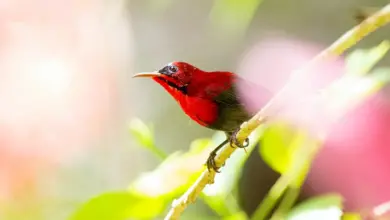Cinnamon Hummingbirds (Amazilia rutila)
The Cinnamon Hummingbirds (Amazilia rutila) is a hummingbird that occurs naturally in the southwestern United States, through northwestern Mexico south to Costa Rica.
It forms a superspecies with the Buff-bellied Hummingbirds (from Texas, USA; Mexico, Belize and Guatemala). Some also include the Escudo Hummingbird (from the remote island ” Escudo de Veraguas” off the Caribbean coast of Panama) and the Loja Hummingbird (Ecuador and Peru); however, they are now considered separate species.
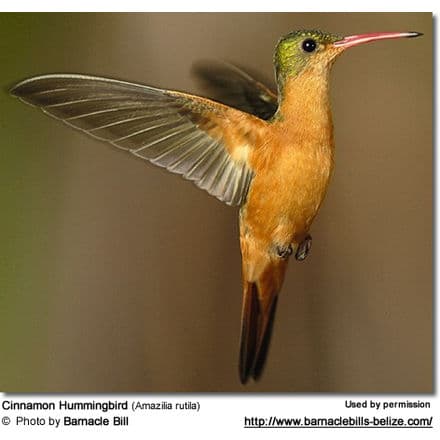
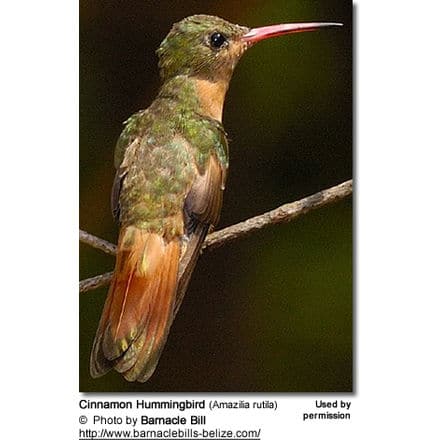
Alternate (Global) Names
Spanish: Amazilia Canela, Colibrí Canela, Colibri Canelo, Colibrí canelo … Italian: Amazilia color cannella, Colibrì cannella … French: Ariane cannelle … German: Rostamazilie, Rost-Amazilie, Zimtbauchamazilie … Chinese: ???? … Czech: Kolibrík ryšavý, kolib?ík ryšavý … Danish: Kanelfarvet Amazilie … Finnish: Kanelitimanttikolibri … Japanese: nikkeihachidori, ???????? … Dutch: Kaneelkleurige Amazilia … Norwegian: Kanelkolibri … Polish: szmaragdzik cynamonowy … Russian: ?????????????? ???????? … Slovak: kolibrík škoricový … Swedish: Kanelkolibri

Distribution / Range
The Cinnamon Hummingbirds occur naturally in the United States (Arizona and New Mexico), western Mexico, Costa Rica, Nicaragua, Guatemala, Belize, El Salvador, Honduras and Panama.
They inhabit moist and dry forests, pine-oak forests. subtropical and tropical degraded former forests and dry shrubland.
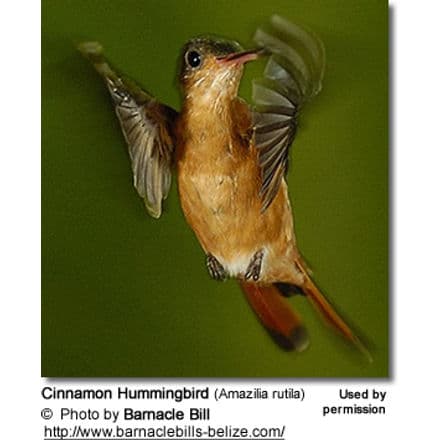
Subspecies and Distribution
-
- Amazilia rutila rutila (Lesson, 1842) – Nominate Race
- Found in western and southwestern Mexico (Jalisco to Oaxaca)
- Amazilia rutila corallirostris synonym saturata (Bourcier and Mulsant, 1846)
- Found in southern and southeastern Mexico (from Chiapas and Yucatán) south to Costa Rica.
- [Amazilia rutila diluta] (Van Rossem, 1938)
- The validity of this subspecies is disputed due to intergradation towards the nominate race
- Found in northwestern Mexico (Sinaloa, Nayarit).
- [Amazilia rutila graysoni] (Lawrence, 1867)
- Some authorities consider this a separate species.
- Found on Islas Marías (“Mary Islands” or Las Tres Marías) off the west Mexican coast
- [Amazilia rutila bangsi]
- Known only from a single Costa Rican specimen. A hybrid of present species and Rufous-tailed Hummingbird (Amazilia tzacatl)
- Amazilia rutila rutila (Lesson, 1842) – Nominate Race
Description
This medium-sized hummingbird is bronze-green with some green iridescence – beginning just below and over the eye, across the crown, and down the back to the rump where the green blends in with the rufous/reddish-brown tail feathers.
The lower parts are cinnamon-colored – from below the eye, down the throat and the chest, and to the undertail feathers. The square tail is reddish with gold and green edging. The long, slim, slightly down-curved bill has a black tip.


Nesting / Breeding
Their breeding season varies according to the geographical region in which they occur. Some breed throughout the year.
Hummingbirds are solitary in all aspects of life other than breeding, and the male’s only involvement in the reproductive process is the actual mating with the female. They neither live nor migrate in flocks, and there is no pair bond for this species.
Males court females by flying in a U-shaped pattern in front of them. He will separate from the female immediately after copulation. One male may mate with several females. In all likelihood, the female will also mate with several males. The males do not participate in choosing the nest location, building the nest, or raising the chicks.
The female is responsible for building the cup-shaped nest out of plant fibers woven together and green moss on the outside for camouflage in a protected location in a shrub, bush, or tree. She lines the nest with soft plant fibers, animal hair, and feathers down, and strengthens the structure with spider webbing and other sticky material, giving it an elastic quality to allow it to stretch to double its size as the chicks grow and need more room. The nest is typically found on a low, thin horizontal branch.
The average clutch consists of two white eggs, which she incubates alone, while the male defends his territory and the flowers he feeds on. The young are born blind, immobile, and without any down.
The female alone protects and feeds the chicks with regurgitated food (mostly partially digested insects since nectar is an insufficient source of protein for the growing chicks). The female pushes the food down the chicks’ throats with her long bill directly into their stomachs.
As is the case with other hummingbird species, the chicks are brooded only the first week or two and left alone even on cooler nights after about 12 days – probably due to the small nest size. The chicks leave the nest when they are about 20 days old.
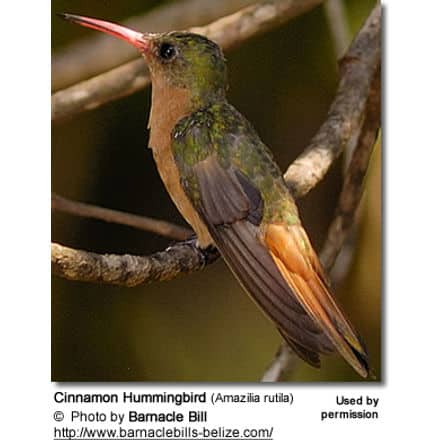
Diet / Feeding
They primarily feed on nectar taken from a variety of brightly colored, scented small flowers of trees, herbs, shrubs and epiphytes. They have been recorded to feed on flowers of Caesalpinia pulcherrima, Cirsium jaliscoense, Croton suberosus, Crusea coccinea, Fuchsia encliandra, Fuschia fulgens, Vitex mollis, Combretum farinosum, Cordia seleriana, Hamelia versicolor, Ceiba aesculifolia, Ipomoea quamoclit, Justicia mexicana, Ipomoea bracteata, Lobelia laxiflora, Opuntia excelsa, Tillandsia paucifolia, Tillandsia dasyrifolia, Tillandsia bartramii, Psittacanthus calyculatus, Ipomoea wolcottiana, as well as Nopalea karwinskiana.
They favor flowers with the highest sugar content (often red-colored and tubular-shaped) and seek out, and aggressively protect, those areas containing flowers with high energy nectar.
They use their long, extendible, straw-like tongues to retrieve the nectar while hovering with their tails cocked upward as they are licking at the nectar up to 13 times per second. Sometimes they may be seen hanging on the flower while feeding.
Many native and cultivated plants on whose flowers these birds feed heavily rely on them for pollination. The mostly tubular-shaped flowers actually exclude most bees and butterflies from feeding on them and, subsequently, from pollinating the plants.
They may also visit local garden nectar feeders for some sugar water, or drink out of bird baths or water fountains where they will either hover and sip water as it runs over the edge; or they will perch on the edge and drink – like all the other birds; however, they only remain still for a short moment.
They also take some small spiders and insects – important sources of protein particularly needed during the breeding season to ensure the proper development of their young. Insects are often caught in flight (hawking); snatched off leaves or branches, or are taken from spider webs.
Males establish feeding territories, where they aggressively chase away other often larger hummingbirds as well as large insects – such as bumblebees, butterflies and hawk moths – that want to feed in their territory. They use aerial flights and intimidating displays to defend their territories.
Metabolism and Survival and Flight Adaptions – Amazing Facts
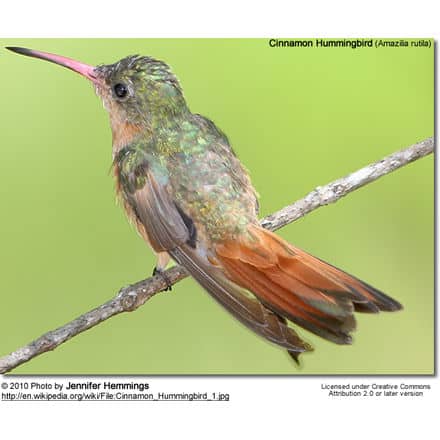
Beauty Of Birds strives to maintain accurate and up-to-date information; however, mistakes do happen. If you would like to correct or update any of the information, please contact us. THANK YOU!!!

